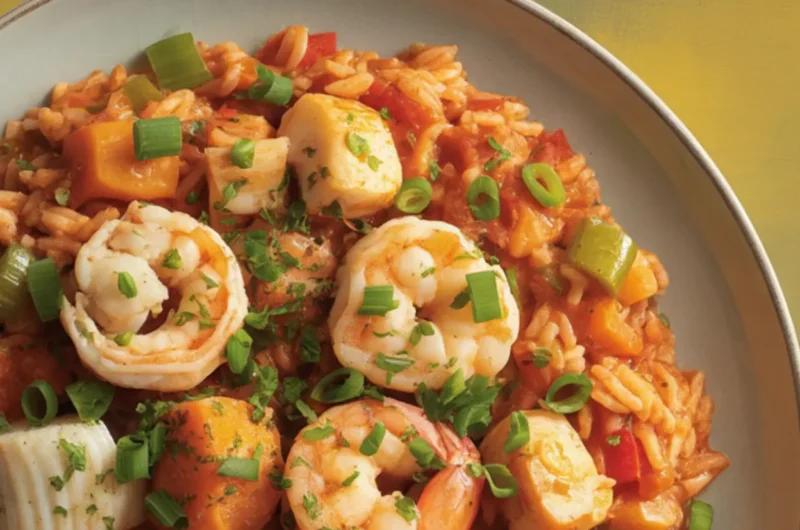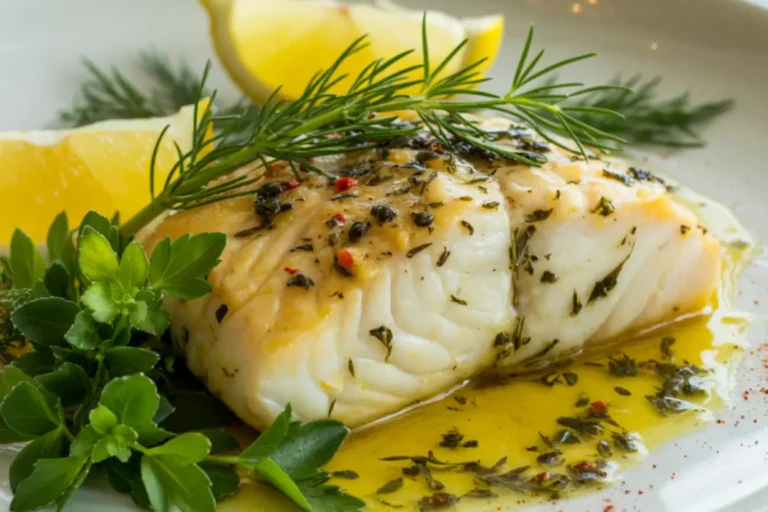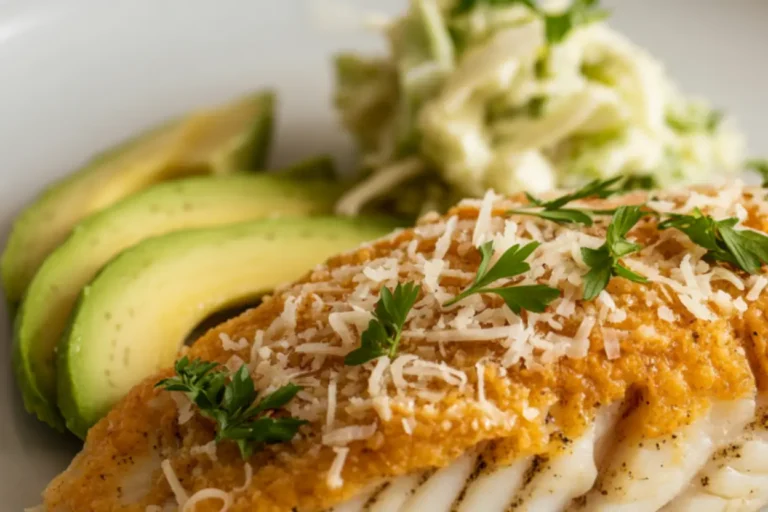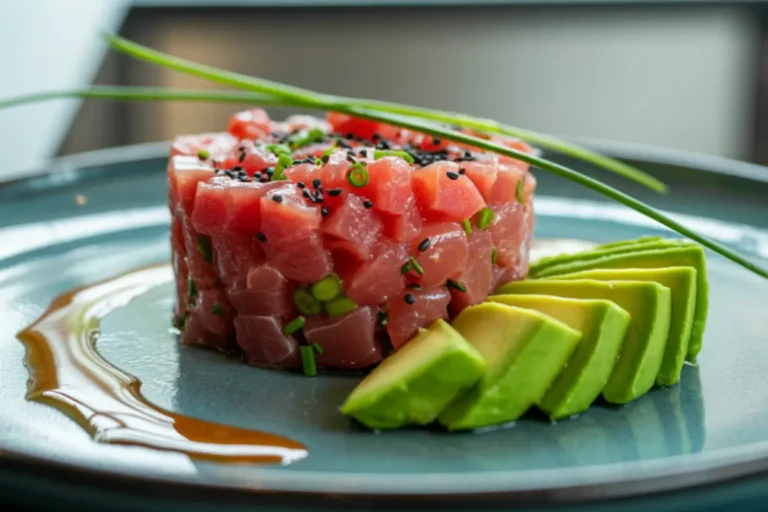Seafood Jambalaya: How to Make It Bold and Flavor-Packed
Table of Contents
There’s something magical about a perfectly executed seafood jambalaya that brings the vibrant spirit of New Orleans right to your dinner table. As someone who’s spent years perfecting this classic Louisiana dish, I can tell you that the key to an exceptional seafood jambalaya lies in building layers of flavor, understanding the right cooking techniques, and respecting the fresh ingredients that make this one-pot wonder truly shine. Today, I’m sharing my tried-and-true method for creating a bold, flavor-packed seafood jambalaya that will transport you straight to Bourbon Street with every spoonful.
Thank you for reading this post, don't forget to subscribe!How to Make Seafood Jambalaya
Quick Overview
Seafood jambalaya is the ultimate crowd-pleasing comfort food that delivers big flavors without requiring professional cooking skills. What makes this dish so special is the harmonious marriage of tender seafood, aromatic vegetables (the “holy trinity” of celery, bell peppers, and onions), fragrant spices, and perfectly cooked rice that absorbs all those incredible flavors. The layering technique I use creates depth and complexity that develops as the dish cooks, resulting in rice that’s infused with a rich, savory seafood essence and a subtle heat that builds with each bite. While jambalaya might seem intimidating at first glance, my streamlined approach makes it accessible even for home cooks with basic skills. From start to finish, you’ll need about 1 hour and 15 minutes (30 minutes of prep time and 45 minutes of cooking), but the results are well worth it – a showstopping one-pot meal that can feed a crowd and actually tastes even better the next day as the flavors continue to meld.
The Ingredients I Use to Bring My Seafood Jambalaya to Life
For the Base:
- 3 tablespoons olive oil
- 1 large onion, finely diced (about 2 cups)
- 1 large green bell pepper, diced (about 1 cup)
- 2 stalks celery, diced (about ¾ cup)
- 4 cloves garlic, minced
- 1 jalapeño, seeded and finely minced (optional, if you want a bit of extra heat)
- 2 bay leaves
- 1 tablespoon dried thyme
- 1 tablespoon dried oregano
- 1 tablespoon smoked paprika
- 2 teaspoons cayenne pepper (adjust to your heat preference)
- 1 teaspoon ground black pepper
- 1 teaspoon white pepper
- 1½ teaspoons salt (adjust to taste)
- 1 can (14.5 oz) diced fire-roasted tomatoes with juice
- 2 tablespoons tomato paste
- 4 cups seafood stock or chicken stock (homemade preferred, but low-sodium store-bought works too)
- 2 cups long-grain white rice, rinsed and drained
For the Seafood:
- 1 pound large shrimp, peeled and deveined (shells reserved for stock if making homemade)
- 1 pound white fish fillets (like cod, halibut, or red snapper), cut into 1-inch chunks
- 1 pound of scallops (or substitute additional shrimp or fish if preferred)
- 8 ounces fresh crab meat, picked over for shells (lump or claw meat works well)
For Finishing:
- 3 green onions, thinly sliced (white and green parts separated)
- ¼ cup fresh parsley, chopped
- 2 tablespoons fresh lemon juice
- Hot sauce to taste (Crystal or Tabasco recommended)
Step-by-Step Instructions
Step 1: Prepare Your Mise en Place
- Before you begin cooking, prepare all your ingredients: chop all vegetables, measure out spices, and ensure your seafood is cleaned and ready.
- Rinse the rice under cold water until it runs clear, then drain it thoroughly. This helps wash away extra starch so the rice cooks up light and fluffy, not sticky.
- If using shell-on shrimp, peel and devein them, reserving the shells for stock if you’re making it from scratch.
- Pat all seafood dry with paper towels – this is crucial for proper searing later.
Step 2: Build the Flavor Base
- In a large, heavy-bottomed Dutch oven or pot, heat the olive oil over medium-high heat until shimmering.
- Add the diced onion, bell pepper, and celery, also known as the “holy trinity.” Cook for 5 to 7 minutes, stirring now and then, until the veggies are tender but not browned.
- Stir in the minced garlic and jalapeño (if you’re using it), and cook for another 30 to 60 seconds, just until everything smells nice and fragrant. Be sure not to let the garlic burn.
- Add all the dried herbs and spices: bay leaves, thyme, oregano, smoked paprika, cayenne, black pepper, white pepper, and salt. Stir continuously for 1 minute to toast the spices and release their essential oils.
- Add the tomato paste and cook for about 2 minutes, stirring constantly to let it deepen in color and flavor. This caramelizes the tomato paste, adding depth of flavor and removing any metallic taste.
Step 3: Create the Base for Your Rice
- Pour in the diced tomatoes with their juice, stirring to combine with the vegetable and spice mixture.
- Add the seafood or chicken stock and bring the mixture to a boil.
- Once boiling, stir in the rinsed rice, making sure it’s evenly distributed throughout the liquid.
- Reduce the heat to low, cover the pot with a tight-fitting lid, and simmer for 15 minutes without disturbing. The rice will absorb most of the liquid and flavor.
Step 4: Prepare to Add the Seafood
- After 15 minutes, check the rice. It should be about 75% cooked, but still have some bite to it. You should still see a bit of liquid left in the pot.
- If the mixture looks too dry, add another ¼ to ½ cup of warm stock or water.
- Season your seafood lightly with salt and pepper while the rice is cooking.
Step 5: Incorporate the Seafood
- Layer the seafood on top of the partially cooked rice in the following order (this accounts for different cooking times):
- First, place the fish pieces gently on top of the rice
- Next, add the scallops
- Then add the shrimp
- Finally, scatter the crab meat over everything
- Do not stir at this point! The seafood will cook in the steam.
- Sprinkle the white parts of the green onions over the top.
- Cover the pot again and cook for an additional 10 minutes on low heat, or until the shrimp are pink, the fish flakes easily, and the rice is tender.
Step 6: Finish and Serve
- Remove the pot from the heat and let it rest, covered, for 5 minutes. This allows the rice to finish absorbing any remaining liquid and lets the seafood finish cooking gently.
- Remove and discard the bay leaves.
- Gently fold in the green parts of the green onions, fresh parsley, and lemon juice, carefully mixing to avoid breaking up the fish.
- Taste and adjust seasoning if necessary, adding more salt, pepper, or hot sauce according to your preference.
- Serve hot in bowls, with additional hot sauce on the side for those who enjoy extra heat.
What to Serve Seafood Jambalaya With
While seafood jambalaya is certainly hearty enough to stand alone as a complete meal, these accompaniments can enhance the dining experience:
- Simple Green Salad: A light salad with mixed greens, cucumber, and a simple vinaigrette provides a fresh contrast to the rich, spicy jambalaya.
- Southern-Style Cornbread: Slightly sweet cornbread is perfect for soaking up the flavorful sauce and balancing the heat of the dish.
- Crusty French Bread: A New Orleans tradition – use it to sop up every last bit of the delicious sauce.
- Pickled Vegetables: The acidity of pickled okra, green tomatoes, or cucumbers cuts through the richness of the jambalaya.
- Collard Greens: For a traditional Southern meal, serve with simply prepared collard greens seasoned with smoked salt instead of traditional ham hock.
- Sweet Iced Tea: The quintessential Southern beverage complements the spicy flavors perfectly.
- Lemon Wedges: Fresh lemon wedges on the side allow guests to add a bright citrus note to their serving if desired.
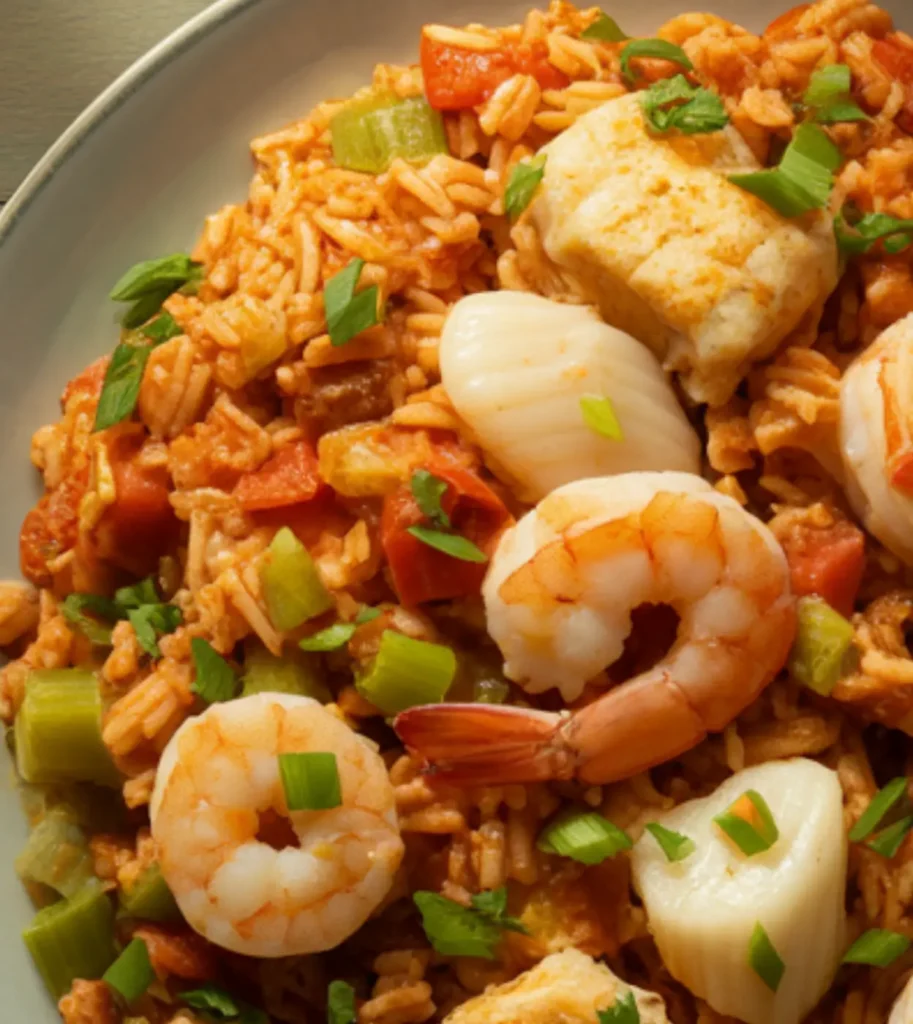
Top Tips for Perfecting Seafood Jambalaya
1. Seafood Selection and Handling
The star ingredients deserve special attention. Always use the freshest seafood available – if you can smell it, it’s not fresh enough. When adding seafood to the jambalaya, follow the layering technique described above rather than stirring it in. This prevents delicate fish from breaking apart and ensures each type cooks properly. If you’re uncertain about availability, frozen shrimp and scallops can work well (thaw completely and pat dry before using), but fresh fish makes a noticeable difference in the final dish.
2. Rice Techniques for Perfect Texture
The rice is arguably as important as the seafood in this dish. Always give your rice a good rinse before cooking to wash away any extra starch. For authentic jambalaya, long-grain white rice works best as it maintains its structure without becoming mushy. Resist the urge to stir the rice while it’s cooking – this activates the starch and can lead to a gummy texture. If you find your jambalaya too soupy, remove the lid during the final few minutes of cooking to allow excess moisture to evaporate.
3. Layering and Building Flavors
The depth of flavor in exceptional jambalaya comes from proper layering techniques. Always sauté your “holy trinity” until properly softened before adding garlic (which burns easily). Toast your spices in the oil to bloom their flavors before adding liquids. Don’t rush the tomato paste browning step – those 2 minutes of caramelization create complex flavors that form the foundation of the dish. These small steps make the difference between good and great jambalaya.
4. Heat Level Management
A common mistake is making jambalaya either too mild or blazing hot. The ideal approach is to build a moderate heat in the base, then offer hot sauce at the table for individual adjustments. Remember that cayenne pepper intensifies as it cooks, so start conservatively – you can always add more later, but you can’t take it away. If you accidentally over-spice your jambalaya, a tablespoon of honey or a splash of coconut milk can help temper the heat without compromising flavor.
5. Timing is Everything
The most common mistake in making seafood jambalaya is overcooking the seafood. Follow the layering method and timing carefully – fish and shellfish continue cooking from residual heat even after the heat is turned off. It’s better to slightly undercook and let it finish during the resting period than to end up with rubbery shrimp and tough fish. The 5-minute rest period is non-negotiable for perfectly cooked seafood and fully developed flavors.
Storing and Reheating Tips
Seafood jambalaya often tastes even better the next day as the flavors have more time to come together. Here’s how to store and reheat it properly to keep it tasting its best:
Storage Guidelines
- Cool Properly: Allow the jambalaya to cool to room temperature before storing, but don’t leave it out for more than 2 hours for food safety.
- Refrigeration:
- Keep it in an airtight container in the fridge, and it’ll stay fresh for up to two days. Seafood dishes have a shorter refrigerator life than meat-based dishes.
- For best results, slightly undercook the seafood if you know you’ll be storing and reheating the jambalaya later.
- Freezing Options:
- If you want to freeze jambalaya, I recommend making the base with rice but without the seafood. Freeze this base for up to 3 months, then add fresh seafood when reheating.
- If freezing with seafood included (less ideal but possible), use within 1 month, and be aware that the texture of the seafood will change somewhat.
- Freeze in portion-sized containers to make reheating easier.
Reheating for Optimal Results
- Stovetop Method (Preferred for large portions):
- Place the jambalaya in a large skillet with a tight-fitting lid.
- Add 2-3 tablespoons of water or stock to provide steam and prevent drying out.
- Heat over medium-low heat, covered, stirring occasionally and gently.
- Heat until the internal temperature reaches 165°F (74°C), about 5-7 minutes depending on quantity.
- Microwave Method (For individual portions):
- Place a single serving in a microwave-safe bowl.
- Sprinkle with 1-2 teaspoons of water or stock.
- Cover with a microwave-safe lid or plate.
- Heat on 70% power for 1 minute, then stir.
- Continue heating in 30-second intervals until heated through.
- Be careful not to overheat, as this will make the seafood tough.
- Oven Method (For large batches without seafood):
- For frozen jambalaya base (without seafood), thaw overnight in the refrigerator.
- Place in an oven-safe dish, cover with foil.
- Heat at 325°F (165°C) until hot throughout (about 20 minutes).
- Separately cook fresh seafood and add to the hot base just before serving.
- Refreshing Reheated Jambalaya:
- Add a squeeze of fresh lemon juice after reheating to brighten flavors.
- Sprinkle with freshly chopped herbs (parsley, green onions) before serving.
- A small dash of hot sauce can revitalize flavor that may have mellowed during storage.
Seafood jambalaya represents the beautiful cultural melting pot that is Louisiana cuisine. With influences from Spanish, French, African, and Caribbean cooking traditions, this dish tells the story of generations of cooks who created something extraordinary from local ingredients and imported spices. By following these detailed steps and incorporating these professional tips, you’ll create a jambalaya that honors this culinary heritage while bringing your own personal touch to the table. The combination of perfectly cooked rice, fresh seafood, and bold, harmonious spices makes this dish a memorable centerpiece for gatherings of all sizes. Whether you’re cooking for a Mardi Gras celebration or simply a weeknight family dinner, this seafood jambalaya is sure to become a requested favorite.
Seafood Jambalaya: How to Make It Bold and Flavor-Packed
Cuisine: Cajun / Creole (Southern U.S., Louisiana)Difficulty: Medium6-8
servings20
minutes40
minutes500-550
kcalA bold and hearty one-pot rice dish bursting with layers of Louisiana flavor, this Seafood Jambalaya features a medley of shrimp, white fish, scallops, and crab, simmered with Cajun spices, aromatics, and rice in a rich tomato-seafood broth. Perfect for family dinners or entertaining guests, it’s comforting, spicy, and packed with coastal goodness.
Ingredients
3 tablespoons olive oil
1 large onion, finely diced (about 2 cups)
1 large green bell pepper, diced (about 1 cup)
2 stalks celery, diced (about ¾ cup)
4 cloves garlic, minced
1 jalapeño, seeded and finely minced (optional, if you want a bit of extra heat)
2 bay leaves
1 tablespoon dried thyme
1 tablespoon dried oregano
1 tablespoon smoked paprika
2 teaspoons cayenne pepper (adjust to your heat preference)
1 teaspoon ground black pepper
1 teaspoon white pepper
1½ teaspoons salt (adjust to taste)
1 can (14.5 oz) diced fire-roasted tomatoes with juice
2 tablespoons tomato paste
4 cups seafood stock or chicken stock (homemade preferred, but low-sodium store-bought works too)
2 cups long-grain white rice, rinsed and drained
1 pound large shrimp, peeled and deveined (shells reserved for stock if making homemade)
1 pound white fish fillets (like cod, halibut, or red snapper), cut into 1-inch chunks
1 pound of scallops (or substitute additional shrimp or fish if preferred)
8 ounces fresh crab meat, picked over for shells (lump or claw meat works well)
3 green onions, thinly sliced (white and green parts separated)
¼ cup fresh parsley, chopped
2 tablespoons fresh lemon juice
Hot sauce to taste (Crystal or Tabasco recommended)
Instructions
- Prep All Your Ingredients
Begin by preparing everything you’ll need. Dice the vegetables, measure the spices, and rinse the rice until the water runs clear to ensure it cooks fluffy. Peel and devein the shrimp if needed, and pat all seafood dry with paper towels to help them sear properly later. If you’re making homemade stock, reserve the shrimp shells. - Build a Flavorful Base
In a large, heavy pot or Dutch oven, heat olive oil over medium-high heat. Sauté the onion, bell pepper, and celery (the Cajun “holy trinity”) for about 5–7 minutes until softened. Stir in garlic and jalapeño for a quick aromatic hit. Add all spices and herbs, stirring to toast them for a minute, then mix in tomato paste and cook for 2 minutes to deepen the flavor. - Cook the Rice in the Base
Stir in the fire-roasted tomatoes with juice, then pour in the seafood or chicken stock and bring everything to a boil. Add the rinsed rice, stir to combine, then lower the heat, cover, and simmer for 15 minutes. The rice should start absorbing the liquid and become partially cooked. - Prepare for the Seafood
After 15 minutes, check that the rice is about 75% cooked and still a little firm. If it looks too dry, add up to ½ cup of warm stock or water. Lightly season your seafood with salt and pepper while the rice finishes its first stage of cooking. - Layer and Steam the Seafood
Layer the seafood directly on top of the rice without stirring. Start with the fish, then the scallops, followed by the shrimp, and finish with the crab. Sprinkle the white parts of the green onions on top. Cover the pot again and let it steam on low for 10 minutes, until the seafood is cooked through and the rice is tender. - Finish and Serve with Fresh Herbs
Turn off the heat and let the pot rest, still covered, for 5 minutes. This finishes the cooking and settles the flavors. Discard the bay leaves, then gently fold in parsley, green onion tops, and lemon juice. Adjust seasoning to taste and serve hot with extra hot sauce on the side.
Notes
- This dish celebrates the spirit of Louisiana cooking, layered, spicy, and soulful. The “holy trinity” of onion, bell pepper, and celery lays the aromatic foundation, while the blend of Cajun spices and seafood adds depth and richness. Feel free to adjust the cayenne and jalapeño to suit your heat tolerance. And if fresh crab isn’t available, subbing more shrimp or fish still delivers amazing flavor.


